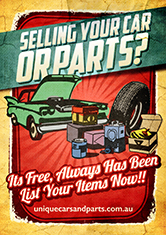Ferrari 400
Reviewed by Unique Cars and Parts
Our Rating: 3
Introduction
An automatic Ferrari - the idea seemed almost like sacrilege when the 400 Automatic was introduced in 1978. Somehow it seemed totally out of keeping with the Italian marque's traditions, as was the fact that the
automatic transmission was from the American giant General Motors. In reality, however, the Ferrari magic easily transcended such considerations; the superb engine was still every inch a Ferrari.
The all-alloy, 4.9-litre V12, with its four camshafts and twelve carburettor chokes (thanks to six twin choke Webers), produced 340bhp and with power like that changing gear was almost superfluous. While the car was designed primarily as an automatic, it would be a strange Ferrari indeed that was not available in some form with a manual gearbox, and in fact a five-speed box was optional on the 400.
From a performance point of view the manual option conferred little advantage. Acceleration was only marginally improved, and the top speed of 152 mph was a mere 3 mph more than the automatic could manage. The somewhat conservative
Pininfarina designed bodyshell illustrated the sort of market aimed at; the 400 could easily be used as a prestigious company car without creating an appearance of extravagant opulence or sheer performance.
The body design was certainly muted but was, nonetheless, elegant, like
Pininfarina's
Lancia Gamma coupe of 1978. The 400's sporting heritage was clearly shown by the
suspension chosen; the classic double wishbones were used all round with
anti-roll bars front and rear. Handling, of course, was in the true Ferrari tradition, being virtually neutral with negligible roll on corners whatever the speed, but the presence of an pneumatic self-levelling system at the rear reminded most motoring journalists that the 400's role was that of a very fast and civilised passenger car.
Awful In Every Way
Unfortunately time would not judge the 400 well. The
Pininfarina-designed lines and relatively limited production numbers may give it potential as a future classic, but it was not universally admired, and is listed at #18 in the BBC's book of "Crap Cars", sandwiched between the Daihatsu Applause and the Austin Ambassador, while Jeremy Clarkson on Top Gear described it as "awful in every way".
Ferrari 400 Quick Specifications:
Engine: Front-mounted, 60 degree V12. 81mm (3.19in) bore x 78mm (3.07 in) stroke - 4823 cc (294.3 cu in). Maximum power (DIN) 340bhp at 6500rpm, maximum torque (DIN) 3121b ft at 6500 rpm, light-alloy cylinder block and head. Compression ratio 8.8:1. 7 main bearings. 2
valves per cylinder operated via thimble
tappets by four overhead camshafts. Six Weber 38 DCOE carburettors.
Transmission: Automatic GM
transmission with torque converter. Ratios 1st 2.520, 2nd 1.520, 3rd 1.00, reverse 1.940. Spiral bevel final drive with limited slip differential, ratio 3.250:1.
Suspension: Front-independent by double wishbones and
anti-roll bar, rear-independent by double wishbones and
anti-roll bar.
Steering: Recirculating ball.
Brakes: Discs front and rear. Dual hydraulic circuit. Servo assisted. Wheels 7.5 in x 15 in.
Tyres: 215/70VR x 15.
Body/chassis: 2 door, 4 seats. Tubular steel frame with steel body.
Dimensions and weight: Wheelbase 106.3in· track-front 57.9in, rear- 59 in' length 189.37 in; width 70.87 in' height 51.57 in' ground clearance 5.12 in' dry weight 3745Ib,' turning circle 41.7ft; fuel tank capacity 26.4 gal.
Performance: Maximum speed 149 mph: acceleration 0-60mph 6.9 secs, fuel consumption approx. 14mpg.



